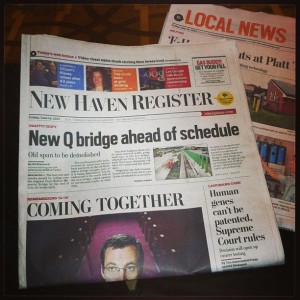
Among those of us who have obsessively followed Alden Global Capital’s destruction of newspapers over the years, there was very little that was new in McKay Coppins’ 7,000-word magnum opus that The Atlantic published this week. Still, Coppins is a gifted writer, and he’s pulled together the full story in a manner that is both elegant and comprehensive.
The arc of Coppins’ narrative is familiar. Alden, a hedge fund, got into the newspaper business about a decade ago. At first, Alden indulged the chief executive it inherited from one of the chains it acquired, John Paton, and then turned on him when he wasn’t willing to go along with the drastic cost-cutting they insisted on. I imagine Alden co-founder Heath Freeman was initially impressed with the blunt, profane Paton, who was not averse to slashing expenses to align them with revenues. The problem was that Paton actually cared about journalism and was not on board with Freeman’s insistence on endless rounds of cuts in order to enrich himself and the other co-founder, Randall Smith.
One fact I hadn’t known previously is that Randall Smith, secretive and a generation or so older than Freeman, is the brother of Russ Smith, founder of the now-defunct New York Press. Russ also founded the Baltimore City Paper, the Washington City Paper and now runs the website Splice Today.
The New York Press was a big deal in the 1990s, as Coppins notes, publishing 10,000-word columns by Smith that attacked the elite media establishment. Smith also once published a lengthy takedown of The Boston Phoenix by another writer that infuriated all of us. I wish I still had a copy. No complaints by me about Smith, though — he wrote a favorable review of my first book for The Wall Street Journal, and I enjoy bantering with him on Twitter about music and baseball.
But back to our story. Coppins’ description of Freeman, the more active and public of the two partners in running Alden’s newspapers, is priceless:
People who know him described Freeman — with his shellacked curls, perma-stubble, and omnipresent smirk — as the archetypal Wall Street frat boy. “If you went into a lab to create the perfect bro, Heath would be that creation,” says one former executive at an Alden-owned company, who, like others in this story, requested anonymity to speak candidly. Freeman would show up at business meetings straight from the gym, clad in athleisure, the executive recalled, and would find excuses to invoke his college-football heroics, saying things like “When I played football at Duke, I learned some lessons about leadership.” (Freeman was a walk-on placekicker on a team that won no games the year he played.)
And Coppins’ description of Alden’s business model is right on target:
What threatens local newspapers now is not just digital disruption or abstract market forces. They’re being targeted by investors who have figured out how to get rich by strip-mining local-news outfits. The model is simple: Gut the staff, sell the real estate, jack up subscription prices, and wring as much cash as possible out of the enterprise until eventually enough readers cancel their subscriptions that the paper folds, or is reduced to a desiccated husk of its former self….
Alden’s calculus was simple. Even in a declining industry, the newspapers still generated hundreds of millions of dollars in annual revenues; many of them were turning profits. For Freeman and his investors to come out ahead, they didn’t need to worry about the long-term health of the assets—they just needed to maximize profits as quickly as possible.
Where I have a bit of a problem with Coppins is that though he credits some of the earlier reporting he relies on, he’s haphazard about it. I winced at his sole reference to Julie Reynolds, whom he quotes indirectly a single time and identifies only as a former reporter for the Monterey Herald in California. In fact, since leaving the paper Reynolds has been indefatigable in reporting on Alden. It was because of her 2017 cover story for The Nation, for instance, that we know Randall Smith used his ill-gotten newspaper gains to buy 16 mansions in Palm Beach, Florida. Just recently she reported for Nieman Lab that Alden’s acquisition of Tribune Publishing was tainted by dubious gamesmanship of the sort that should have prompted a do-over.
Then there’s the Baltimore hotel magnate Stewart Bainum, whose bid to buy Tribune fell short this past spring. In August, Rick Edmonds of Poynter reported that Bainum was launching a well-funded digital news nonprofit in order to compete with Alden’s Baltimore Sun. Coppins writes about that without giving any credit, and it’s being repeated in media circles as though it was his scoop.
But these are quibbles. Coppins is a gifted writer and has done a prodigious amount of reporting of his own.
Recently The Atlantic published an essay by Elaine Godfrey about the damage done to her hometown newspaper in Iowa by Gannett, the country’s largest newspaper chain. (Alden’s holdings come in second.)
The Atlantic deserves credit for using its prestige to focus on the local news crisis, and on the Wall Street greed that has transformed it into a catastrophe.





